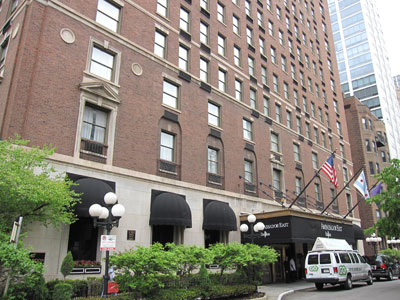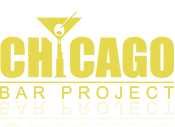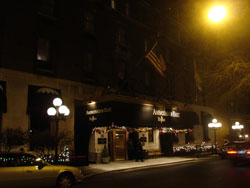 Deep within the heart of Chicago’s Gold Coast is one of the last vestiges of its Golden Age, when celebrities like Humphrey Bogart, Clark Gable and Frank Sinatra dropped by on layovers between the Super Chief and Twentieth Century Limited. The Pump Room has weathered many a storm, from the decline of rail transportation to Sonny Bono to an over abundance of white gym shoes. However, the Pump Room still rivals every other luxury hotel, elegant restaurant and swanky cocktail lounge in town, and has them all beat with its colorful history. They also serve a mean filet mignon, sage martini and Sunday brunch.
Deep within the heart of Chicago’s Gold Coast is one of the last vestiges of its Golden Age, when celebrities like Humphrey Bogart, Clark Gable and Frank Sinatra dropped by on layovers between the Super Chief and Twentieth Century Limited. The Pump Room has weathered many a storm, from the decline of rail transportation to Sonny Bono to an over abundance of white gym shoes. However, the Pump Room still rivals every other luxury hotel, elegant restaurant and swanky cocktail lounge in town, and has them all beat with its colorful history. They also serve a mean filet mignon, sage martini and Sunday brunch.
“The most exotic dining place in the U.S. The ultimate in cuisine and culinary showmanship.”
– Life magazine (1943)
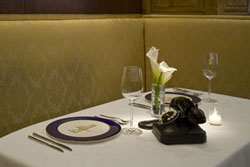 You’ll find the Ambassador East Hotel at the northeast corner of State Parkway and Goethe Street. Pass by the uniformed valets, through the revolving door, up the marble stairs, and you’ll find the Pump Room on your left, behind a wall of glass. The entrance was once located through a portal directly in the lobby but is now further down on your left. There you’ll find an mahogany paneled hallway filled from floor to ceiling with photographs of the legion of celebrities that have patronized the Pump Room. The maitre’d will seat you or pass you off to the stately bar that overlooks the grand dining space that is the Pump Room.
You’ll find the Ambassador East Hotel at the northeast corner of State Parkway and Goethe Street. Pass by the uniformed valets, through the revolving door, up the marble stairs, and you’ll find the Pump Room on your left, behind a wall of glass. The entrance was once located through a portal directly in the lobby but is now further down on your left. There you’ll find an mahogany paneled hallway filled from floor to ceiling with photographs of the legion of celebrities that have patronized the Pump Room. The maitre’d will seat you or pass you off to the stately bar that overlooks the grand dining space that is the Pump Room.
“Booth One” is the most sought after seat in the house, as those celebrities sitting there could be seen from the lobby, the bar and the rest of the room. The booth opposite along the east wall was almost as popular and offers one of the best views of the room, where you’ll obsere a crowd consisting of Gold Coast upper crusters, executives on an expense account, and the occasional well-dressed tourist with a high credit card limit. Once requiring a jacket and tie for the men, the Pump Room has relaxed the dress code but still requires more of a business casual attire – those wearing jeans, t-shirts, gym shoes, or baseball hats, need not apply.
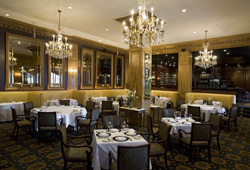 The Pump Room consists of sunken, carpeted dining area lined with the signature high-backed, off-white booths under a heavily mirrored wall, surrounding wooden tables with padded chairs set under a series of chandeliers and amongst oak paneled columns. This is where you want to sit so, if there’s an empty booth and they stick you out towards the windows, be sure to ask them for the real deal. If you’re a celebrity, this will of course be unnecessary… assuming they recognize you.
The Pump Room consists of sunken, carpeted dining area lined with the signature high-backed, off-white booths under a heavily mirrored wall, surrounding wooden tables with padded chairs set under a series of chandeliers and amongst oak paneled columns. This is where you want to sit so, if there’s an empty booth and they stick you out towards the windows, be sure to ask them for the real deal. If you’re a celebrity, this will of course be unnecessary… assuming they recognize you.
The menu consists of contemporary American fare, presented with flair. Sunday brunch is also popular with locals. An impressive wine list is available accompanied by champagne and the bar’s signature drink, the sage margarita. These days, the Pump Room is not nearly the most expensive meal in town, but it will set you back $100 per couple with a bottle of wine. I’ve eaten here twice and the food is good but you’re paying for the pleasure of experiencing a legend. For entertainment, you’ll find live piano jazz every Friday and Saturday night from 8:00pm, and you might even find some swinging couples as the evening wears on.
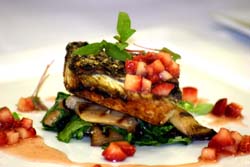 The legend began when the hotelier, Ernie Byfield, opened the Pump Room on October 1, 1938, replacing a dining room of little distinction. Byfield was inspired by the 18th Century original as described by Booth Tarkington in Monsieur Beaucaire, where royalty mixed with commoners in Bath, England, under the watchful eye of Master of Cermonies and dandy, Beau Nash. The original Pump Room, still operating today, was named after the warm mineral water pumped into a fountain where an attendant filled glasses for patrons. Byfield’s Pump Room became a celebrity magnet, beginning with Broadway actress, Gertrude Lawrence, who held court in Booth One for 90 days straight while performing Susan and God at the now-defunct Harris Theater in town. Afterwards, a commemorative plaque was affixed to the wall that read, “This table is reserved for Miss Gertrude Lawrence whenever she is in Chicago.” Years later, an angered regular seeing it for the 100th time cried, “To hell with that!” and hurled it to the floor. It was replaced and hung until Lawrence’s death in 1952.
The legend began when the hotelier, Ernie Byfield, opened the Pump Room on October 1, 1938, replacing a dining room of little distinction. Byfield was inspired by the 18th Century original as described by Booth Tarkington in Monsieur Beaucaire, where royalty mixed with commoners in Bath, England, under the watchful eye of Master of Cermonies and dandy, Beau Nash. The original Pump Room, still operating today, was named after the warm mineral water pumped into a fountain where an attendant filled glasses for patrons. Byfield’s Pump Room became a celebrity magnet, beginning with Broadway actress, Gertrude Lawrence, who held court in Booth One for 90 days straight while performing Susan and God at the now-defunct Harris Theater in town. Afterwards, a commemorative plaque was affixed to the wall that read, “This table is reserved for Miss Gertrude Lawrence whenever she is in Chicago.” Years later, an angered regular seeing it for the 100th time cried, “To hell with that!” and hurled it to the floor. It was replaced and hung until Lawrence’s death in 1952.
“History [of a cafe society sort] has been made in the Pump Room… There was the night an Ambassador ambassador invited Oleg Cassini, famed woman’s dress designer, to clean up his language or step outside to defend himself with his fists… There was the night a year ago last November, just days before the election, when Bobby Kennedy and others of candidate Jack Kennedy’s touring campaign party huddled there, in the corner farthest removed from booth No. 1, with local Democratic leaders. Was Chicago’s vote, and the electoral vote of Illinois settled right then and there?”
– excerpt from William Leonard’s Chicago Tribune article, “Triumph and Heartbreak Have Followed Celebrities to The Pump Room” (March 25, 1962)
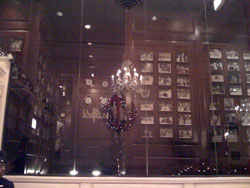 Since then, Booth One has seen many on the A-List: Bogart and Bacall got bombed on their Honeymoon, John Barrymore was once so drunk the staff watered down his drinks, Frank Sinatra sang about it in Chicago, “Chicago is the jumpin’ Pump Room,” and wrote about it in his autobiography My Way, and Salvador Dali drew on a tablecloth. In the Ginger Rodgers & Fred Astaire movie, The Story of Vernon and Irene Castle (1939), the chorus sings, “We’ll meet at the Pump Room-Ambassador East/To say the least, on shish kebab and breast of squab we will feast/And get fleeced.” Other famous guests include Marilyn Monroe, Dwight D. Eisenhower, the Duke & Duchess of Windsor, Ronald Reagan, Bob Hope, Liz Taylor, Zsa Zsa Gabor, Alfred Hitchcock, Jackie Gleason, Jack Benny, Jayne Mansfield, Liberace, Jerry Lewis, Ed Sullivan, Kukla, Fran & Ollie, and even Lassie and Morris the Cat. Alternatively, Clark Gable never cared for the hullabaloo and chose to eat by a table next to the kitchen. Sonny Bono was the first allowed in without a jacket, but Phil Collins was later refused without one, primarily because he came and went unrecognized. He later recorded the album, No Jacket Required, and the Pump Room sent him a new jacket of their own in apology.
Since then, Booth One has seen many on the A-List: Bogart and Bacall got bombed on their Honeymoon, John Barrymore was once so drunk the staff watered down his drinks, Frank Sinatra sang about it in Chicago, “Chicago is the jumpin’ Pump Room,” and wrote about it in his autobiography My Way, and Salvador Dali drew on a tablecloth. In the Ginger Rodgers & Fred Astaire movie, The Story of Vernon and Irene Castle (1939), the chorus sings, “We’ll meet at the Pump Room-Ambassador East/To say the least, on shish kebab and breast of squab we will feast/And get fleeced.” Other famous guests include Marilyn Monroe, Dwight D. Eisenhower, the Duke & Duchess of Windsor, Ronald Reagan, Bob Hope, Liz Taylor, Zsa Zsa Gabor, Alfred Hitchcock, Jackie Gleason, Jack Benny, Jayne Mansfield, Liberace, Jerry Lewis, Ed Sullivan, Kukla, Fran & Ollie, and even Lassie and Morris the Cat. Alternatively, Clark Gable never cared for the hullabaloo and chose to eat by a table next to the kitchen. Sonny Bono was the first allowed in without a jacket, but Phil Collins was later refused without one, primarily because he came and went unrecognized. He later recorded the album, No Jacket Required, and the Pump Room sent him a new jacket of their own in apology.
“
After Byfield’s death in 1950, The Pump Room held on to its allure as a place for stargazing. A new generation of luminaries took up residence in Booth One. Mel Brooks personally greeted each guest; Paul Newman and Robert Redford lunched on ham sandwiches and pilsners every day during the shooting of ‘The Sting.’ Michael J. Fox, Eddie Murphy and Jim Belushi have all continued the tables’ famous tradition.”
– Executive Chef, Nick Sutton, on the Pump Room website
The Pump Room went bankrupt in 1975 but was bought by Lettuce Entertain You Enterprises, who restored its elegance from tatters, though at a cost of the original white-leather booths with matching tableside phone in Booth One, walls of deep blue felt, flaming swords, and coffee boys wearing white turbans, all of which faded into the mists of time.
“
Back in 1958, when Queen Elizabeth II dropped in to the Pump Room and its Ambassador East hotel for a two-hour luncheon after opening the St. Lawrence Seaway, Lucio Perrigo [PR maven] spent weeks preparing for the visit, following a 60-page typed sheet of protocol sent by the British consulate. For all her troubles, Perrigo whispered, she claimed herself a prize. ‘This is something no one knows,’ she said, inching up close. ‘When she left, we unhinged the toilet seat from her suite and put it in a shadow box with a bright brass plate saying, ‘Her Majesty, Queen Elizabeth II, sat here.” Then they shipped the ‘throne’ off to hotelier Pat Hoy’s farm, where it graced a trophy wall for years.”
– excerpt from Barbara Mahany’s Chicago Tribune article, “Delicious Tidbits of a Storied Spot”
(August 21, 1988)
 Today, the Pump Room is run by the Portfolio Hotel Group and executive chef, Nick Sutton. They’ve done a good job but the Pump Room has long since ceased to be a destination for more than the occasional celebrity. One can’t help but think that the Pump Room’s owners are at risk of wasting its legacy by being posh for posh’s sake rather than making more of its incredible history, perhaps with a wee bit of marketing that could both preserve and enhance its legacy… Regardless, the Pump Room is a Chicago treasure to be cherished and will satisfy any nostalgic urges to experience the city in its Golden Age, and there’s no better place to get sauced in such fine a manner. If you want to be particularly extravagent, head to Pops for Champagne just a bit south on State for further indulgence in the form of a nightcap. For more information, check out the Pump Room website.
Today, the Pump Room is run by the Portfolio Hotel Group and executive chef, Nick Sutton. They’ve done a good job but the Pump Room has long since ceased to be a destination for more than the occasional celebrity. One can’t help but think that the Pump Room’s owners are at risk of wasting its legacy by being posh for posh’s sake rather than making more of its incredible history, perhaps with a wee bit of marketing that could both preserve and enhance its legacy… Regardless, the Pump Room is a Chicago treasure to be cherished and will satisfy any nostalgic urges to experience the city in its Golden Age, and there’s no better place to get sauced in such fine a manner. If you want to be particularly extravagent, head to Pops for Champagne just a bit south on State for further indulgence in the form of a nightcap. For more information, check out the Pump Room website.
